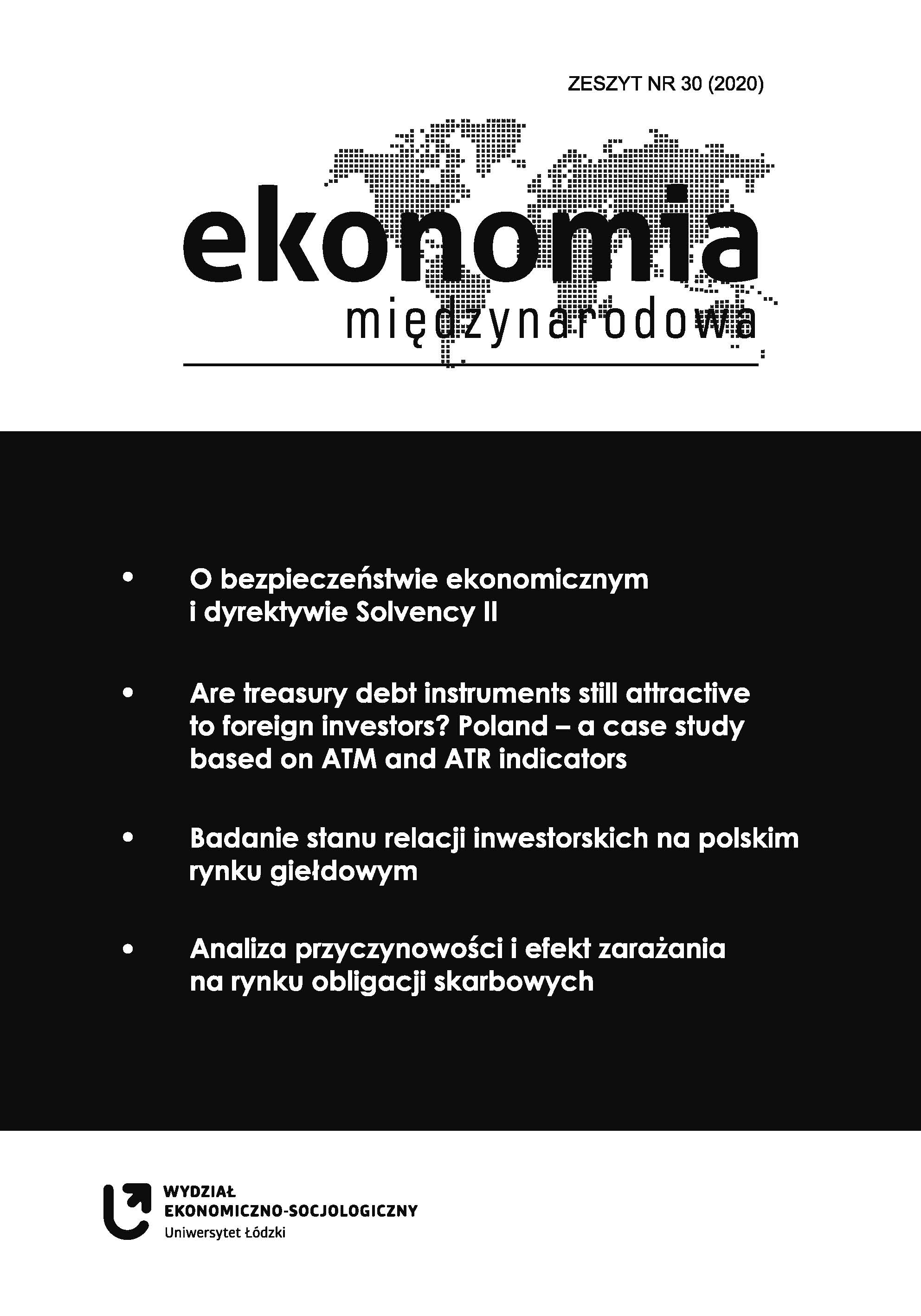Causality analysis and contagion effect on the treasury bond market
DOI:
https://doi.org/10.18778/2082-4440.30.04Keywords:
bond market, contagion effect, Granger causality, financial crisisAbstract
The paper examines relationships between selected treasury bond market in Europe. The study focuses on two periods: from January 2006 to December 2018 and from January 2010 to December 2013. For the first period bivariate vector autoregressive model was used with weekly data. The empirical results indicated bidirectional relationships for developed markets and unidirectional causality for Greece and Central Europe. The second period concerns the crisis of public finances in Greece. In this case, the aim of the study was to determine the so-called contagion effect in treasury bonds market. The analysis confirmed the contagion effect for countries with low credit ratings.
References
Afonso A., Arghyrou M., Bagdatoglou G., Kontonikas A. (2015), On the time-varying relationship between EMU sovereign spreads and their determinants, „Economic Modelling”, 44.
Google Scholar
DOI: https://doi.org/10.1016/j.econmod.2014.07.025
Arghyrou M.C., Kontonikas A. (2012), The EMU sovereign-debt crisis: Fundamentals, expectations and contagion, „Journal of International Financial Markets, Institutions & Money”, 22.
Google Scholar
DOI: https://doi.org/10.1016/j.intfin.2012.03.003
Babalos V., Kyei C., Poutos E.I. (2015), Causality and Contagion in EMU Sovereign Bonds Revisited: Novel Evidence from Nonlinear Causality Tests, „Working Papers” 14, University of Pretoria, Department of Economics.
Google Scholar
Beetsma R., Giuliodori M., Jong F., Widijanto D. (2013), Spread the news: The impact of news on the European sovereign bond markets during the crisis, „Journal of International Money and Finance”, 34.
Google Scholar
DOI: https://doi.org/10.1016/j.jimonfin.2012.11.005
Bernoth K., Erdogan B. (2012), Sovereign bond yield spreads: A time-varying coefficient approach, „Journal of International Money and Finance”, 31.
Google Scholar
DOI: https://doi.org/10.1016/j.jimonfin.2011.10.006
Bernoth K., Hagen J., Schuknecht L. (2012), Sovereign risk premiums in the European government bond market, „Journal of International Money and Finance”, 31.
Google Scholar
DOI: https://doi.org/10.1016/j.jimonfin.2011.12.006
Bieńkowski W., Gawrońska-Nowak B., Grabowski W. (2011), Podatność polskich rynków finansowych na niestabilności wewnętrzne i zewnętrzne, „Materiały i Studia”, 258, Narodowy Bank Polski.
Google Scholar
Brzeszczyński J., Kelm R. (2002), Ekonometryczne modele rynków finansowych, WIG-Press, Warszawa.
Google Scholar
Burzała M. (2015), Zmiana wartości oczekiwanej i wariancji stóp zwrotu z indeksów giełdowych w czasie kryzysu. Zarażanie czy wzajemne zależności rynków kapitałowych? „Zeszyt Naukowe Uniwersytetu Szczecińskiego, Finanse, Rynki Finansowe, Ubezpieczenia”, 75.
Google Scholar
DOI: https://doi.org/10.18276/frfu.2015.75-07
Clare A., Lekkos I. (2000), An analysis of the relationship between international bond markets, „Working paper”, Bank of England.
Google Scholar
DOI: https://doi.org/10.2139/ssrn.258021
Dickey D.A., Fuller W.A. (1979), Distribution of the estimators for autoregressive time-series with a unit root, „Journal of the American Statistical Association”, 74.
Google Scholar
DOI: https://doi.org/10.2307/2286348
Ejsing J., Lemke W. (2009), The Janus-headed salvation: Sovereign and bank credit risk premia during 2008–2009, „Working Paper” 1127, European Central Bank.
Google Scholar
DOI: https://doi.org/10.2139/ssrn.1517102
Engle R.F., Granger C.W.J. (1987), Co-integration and error correction: Representation, estimation and testing, „Econometrica”, 55.
Google Scholar
DOI: https://doi.org/10.2307/1913236
Gennaioli N., Martin A., Rossi S. (2014), Sovereign default, domestic banks and financial institutions, „Journal of Finance”, 69.
Google Scholar
DOI: https://doi.org/10.1111/jofi.12124
Gomez-Puig M., Sosvilla-Rivero S. (2014), Causality and contagion in EMU sovereign debt markets, „International Review of Economics & Finance”, 33.
Google Scholar
DOI: https://doi.org/10.2139/ssrn.2405929
Gorea D., Radev D. (2014), The euro area sovereign debt crisis: Can contagion spread from the periphery to the core? „International Review of Economics and Finance”, 30.
Google Scholar
DOI: https://doi.org/10.1016/j.iref.2013.10.003
Granger C.W.J. (1969), Investigating causal relations by econometric models and cross-spectral methods, „Econometrica”, 37.
Google Scholar
DOI: https://doi.org/10.2307/1912791
Kalbaska A., Gatkowski M. (2012), Eurozone sovereign contagion: Evidence from the CDS market (2005–2010), „Journal of Economic Behaviour and Organization”, 83.
Google Scholar
DOI: https://doi.org/10.1016/j.jebo.2012.05.010
Karkowska R. (2015), The application of GARCH(1,1) model for measuring shocks transmission in bond market, „Acta Universitatis Lodziensis. Folia Oeconomica”, 3(314).
Google Scholar
DOI: https://doi.org/10.18778/0208-6018.314.07
Kim S.J., Lucey B.M., Wu E. (2005), Dynamics of Bond Market Integration between Established and New European Union Countries, „Journal of International Financial Markets, Institutions and Money”, 16.
Google Scholar
DOI: https://doi.org/10.1016/j.intfin.2004.12.004
Kwiatkowski D., Phillips P.C.B., Schmidt P., Shin Y. (1992), Testing the null hypothesis of stationarity against the alternative of a unit root: How sure are we that economic time series have a unit root?, „Journal of Econometrics”, 54.
Google Scholar
DOI: https://doi.org/10.1016/0304-4076(92)90104-Y
Maltritz D. (2012), Determinants of sovereign yield spreads in the Eurozone: A Bayesian approach, „Journal of International Money and Finance”, 31.
Google Scholar
DOI: https://doi.org/10.1016/j.jimonfin.2011.10.010
Metiu N. (2012), Sovereign risk contagion in the Eurozone, „Economics Letters”, 117.
Google Scholar
DOI: https://doi.org/10.1016/j.econlet.2012.04.074
Syllignakis M.N., Kouretas G.P. (2011), Dynamic correlation analysis of financial contagion: Evidence from the Central and Eastern European markets, „International Review of Economics and Finance”, 20.
Google Scholar
DOI: https://doi.org/10.1016/j.iref.2011.01.006
Downloads
Published
How to Cite
Issue
Section
License

This work is licensed under a Creative Commons Attribution-NonCommercial-NoDerivatives 4.0 International License.









